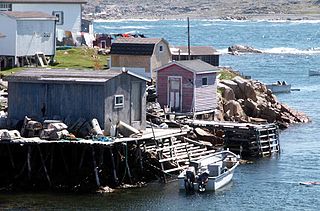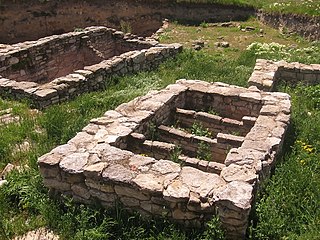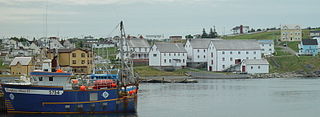
Stockfish is unsalted fish, especially cod, dried by cold air and wind on wooden racks on the foreshore. The drying of food is the world's oldest known preservation method, and dried fish has a storage life of several years. The method is cheap and effective in suitable climates; the work can be done by the fisherman and family, and the resulting product is easily transported to market.

An outport is the term given for a small coastal community in the Canadian province of Newfoundland and Labrador other than the chief port of St. John's. Originally, the term was used for coastal communities on the island of Newfoundland, but the term has now been adopted for those on the mainland area of Labrador as well.
"I'se The B'y" is a traditional Newfoundland folk song/ballad. "I's the B'y" is in the Newfoundland English dialect, and translates to standard English as "I'm the Boy" or "I'm the Guy". The Canadian Songwriters Hall of Fame decided to honour the song in 2005, officially accepting it as part of the Canadian Song Hall of Fame.

Battle Harbour is a summer fishing station, formerly a permanent settlement, located on the Labrador coast in the province of Newfoundland and Labrador, Canada. Battle Harbour was for two centuries the economic and social centre of the southeastern Labrador coast. Mercantile saltfish premises first established there in the 1770s developed into a thriving community that was known as the Capital of Labrador. It fell into decline following reductions in the cod fishery and a major fire in 1930, and was abandoned as a permanent settlement following government resettlement activity in the 1960s.

Port Saunders is a community of 674 located in Newfoundland and Labrador, Canada. It had a population of 336 in 1940 and 522 in 1956.
The province of Newfoundland and Labrador had three main types of fishery in the 19th century: sealing, migratory and inshore fishery.

Fresh fish rapidly deteriorates unless some way can be found to preserve it. Drying is a method of food preservation that works by removing water from the food, which inhibits the growth of microorganisms. Open air drying using sun and wind has been practiced since ancient times to preserve food. Water is usually removed by evaporation but, in the case of freeze-drying, food is first frozen and then the water is removed by sublimation. Bacteria, yeasts and molds need the water in the food to grow, and drying effectively prevents them from surviving in the food.
Broad Cove is on King's Island, Placentia Bay, Newfoundland, Canada. It was one of five communities on King's Island; the others were: Tack's Beach, Best Harbour, Baker's Cove, Cooper's Cove and Yaulis Cove. All the communities had the same postal address, which was "Tacks Beach, Placentia Bay, Newfoundland".

Conche is a community on the Northern Peninsula of Newfoundland and Labrador, Canada. Its population in 2016 was 170.

Dried and salted cod, sometimes referred to as salt cod or saltfish, is cod which has been preserved by drying after salting. Cod which has been dried without the addition of salt is stockfish. Salt cod was long a major export of the North Atlantic region, and has become an ingredient of many cuisines around the Atlantic and in the Mediterranean. With the sharp decline in the world stocks of cod, other salted and dried white fish are sometimes marketed as "salt cod", and the term has become to some extent a generic name.

Southport is a community in the Canadian province of Newfoundland and Labrador, located on the southern side of the entrance to Trinity Bay's Southwest Arm, about 41 km southeast of Clarenville. Its latitude and longitude are 48°02'59"N, 53°37'59"W.

A fishing stage is a wooden vernacular building, typical of the rough traditional buildings associated with the cod fishery in Newfoundland, Canada. Stages are located at the water's edge or "landwash", and consist of an elevated platform on the shore with working tables and sheds at which fish are landed and processed for salting and drying. Traditionally, they are painted with a red ochre paint, though colours other than red are sometimes seen.
The stage is unique among British and North American outbuildings because unlike the typical uses of agricultural structures, both the slaughter and the processing of a harvested animal takes place within this space. While barns and stables were intended for year-round housing of live animals, the stage would be used only for several months during the summer, and not as a shelter for livestock.

Bay de Verde is an incorporated town in Conception Bay on the northern tip of the Bay de Verde Peninsula of Newfoundland and Labrador, Canada. The first recorded inhabitants at Bay de Verde arrived in 1662. Bay de Verde became an incorporated town in 1950.

Salted fish, such as kippered herring or dried and salted cod, is fish cured with dry salt and thus preserved for later eating. Drying or salting, either with dry salt or with brine, was the only widely available method of preserving fish until the 19th century. Dried fish and salted fish are a staple of diets in the Caribbean, North Africa, South Asia, Southeast Asia, Southern China, Scandinavia, parts of Canada including Newfoundland, coastal Russia, and in the Arctic. Like other salt-cured meats, it provides preserved animal protein even in the absence of refrigeration.
Winterton is a town in the Canadian province of Newfoundland and Labrador. It was originally named Sille Cove or Scilly Cove. In 1912 the town was named Winterton for Sir James Spearman Winter, former Prime Minister of Newfoundland.

Ancient methods of preserving fish included drying, salting, pickling and smoking. All of these techniques are still used today but the more modern techniques of freezing and canning have taken on a large importance.

Cod fishing in Newfoundland was carried out at a subsistence level for centuries, but large scale fishing began shortly after the European discovery of the North American continent in 1492, with the waters being found to be preternaturally plentiful, and ended after intense overfishing with the collapse of the fisheries in 1992.

Cod fisheries are fisheries for cod. Cod is the common name for fish of the genus Gadus, belonging to the family Gadidae, and this article is confined to three species that belong to this genus: the Atlantic cod, the Pacific cod and the Greenland cod. Although there is a fourth species of the cod genus Gadus, Alaska pollock, it is commonly not called cod and therefore currently not covered here.

The Ryan Premises is a National Historic Site of Canada located in the town of Bonavista, Newfoundland and Labrador. It is preserved as an example of a large-scale merchant operation in a Newfoundland outport.
A bark pot is the vernacular name of a vessel in Newfoundland English, used to hold an infusion of tree bark in which fishers would dip nets, cod traps, lines, or sails to preserve them. It was an integral piece of technology for the early inshore cod fishery of Newfoundland and Labrador. It was also the term used for a vessel used to make a solution of bark for tanning leather. Also known as a barking kettle, barking pot, or tan pot, it was often made of iron or copper.

















